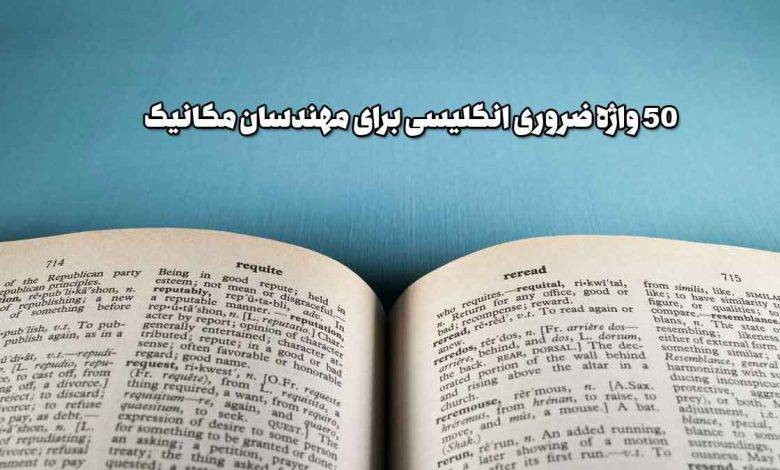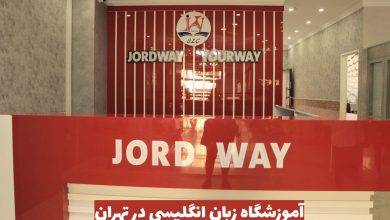
مهندسی مکانیک یکی از رشتههای حیاتی و چندوجهی است که نیاز به تسلط بر واژگان خاص دارد. در این مطلب، به بررسی 50 واژه ضروری انگلیسی برای مهندسان مکانیک میپردازیم و برای هر واژه، مثالهای پیچیدهای ارائه میدهیم تا درک بهتری از کاربرد آنها داشته باشید.
- بیشتر بخوانید: تسلط بر ضمایر ملکی انگلیسی: کلید ساخت جملات قویتر
1. Torque (گشتاور)
- تعریف: نیرویی که باعث چرخش یک جسم حول محور خود میشود.
- مثال: “The torque generated by the engine must be sufficient to overcome the inertia of the vehicle during acceleration”
2. Kinematics (حرکتشناسی)
- تعریف: مطالعه حرکت اجسام بدون توجه به نیروهای وارد بر آنها.
- مثال: “In kinematics, we analyze the trajectory of the projectile to determine its maximum height and range.”
3. Dynamics (دینامیک)
- تعریف: مطالعه نیروها و تأثیر آنها بر حرکت اجسام.
- مثال: “The dynamics of the system were modeled using differential equations to predict the behavior under various loading conditions.”
4. Fluid Mechanics (مکانیک سیالات)
- تعریف: مطالعه رفتار سیالات در حالتهای سکون و حرکت.
- مثال: “Fluid mechanics principles are applied to design hydraulic systems that efficiently transfer energy.”
5. Thermodynamics (ترمودینامیک)
- تعریف: مطالعه انرژی و انتقال آن در سیستمهای حرارتی.
- مثال: “The second law of thermodynamics states that energy transformations are not 100% efficient, leading to entropy increase.”
6. Stress (تنش)
- تعریف: نیروی وارد بر واحد سطح یک جسم.
- مثال: “The stress concentration at the notches of the beam can lead to premature failure under cyclic loading conditions.”
7. Strain (کرنش)
- تعریف: تغییر شکل نسبی یک جسم تحت بارگذاری.
- مثال: “The strain experienced by the material was measured using strain gauges during the tensile test.”
8. Fatigue (خستگی)
- تعریف: کاهش استحکام یک ماده به دلیل بارگذاری مکرر.
- مثال: “Fatigue analysis was conducted to predict the lifespan of the component under cyclic loading conditions.”
9. Vibration (ارتعاش)
- تعریف: نوسانات مکانیکی در یک سیستم.
- مثال: “The vibration analysis revealed resonant frequencies that could lead to catastrophic failure if not mitigated.”
10. Heat Transfer (انتقال حرارت)
- تعریف: فرآیند انتقال انرژی حرارتی بین اجسام.
- مثال: “The heat transfer coefficient was calculated to optimize the thermal efficiency of the heat exchanger.”
11. Load (بار)
- تعریف: نیرویی که بر یک جسم اعمال میشود.
- مثال: “The load distribution on the beam was analyzed to ensure it remained within safe limits during operation.”
12. Tension (کششی)
- تعریف: نیروی کششی که بر یک جسم وارد میشود.
- مثال: “The tension in the cable was monitored to prevent excessive elongation that could compromise the structure’s integrity.”
13. Compression (فشاری)
- تعریف: نیروی فشاری که بر یک جسم وارد میشود.
- مثال: “The compression test results indicated that the material could withstand significant loads without yielding.”
14. Equilibrium (تعادل)
- تعریف: وضعیتی که در آن نیروها و گشتاورها در یک سیستم برابرند.
- مثال: “The system was analyzed for static equilibrium to ensure that all forces were balanced.”
15. CAD (طراحی به کمک کامپیوتر)
- تعریف: استفاده از نرمافزار برای طراحی و مدلسازی.
- مثال: “The CAD model allowed for precise adjustments to be made before the physical prototype was constructed.”
16. Simulation (شبیهسازی)
- تعریف: مدلسازی رفتار یک سیستم برای پیشبینی عملکرد آن.
- مثال: “The simulation of the mechanical system provided insights into potential failure modes under extreme conditions.”
17. Material Properties (خواص مواد)
- تعریف: ویژگیهای فیزیکی و شیمیایی مواد.
- مثال: “Understanding the material properties is crucial for selecting the right material for high-stress applications.”
18. Welding (جوشکاری)
- تعریف: فرآیند اتصال دو یا چند قطعه فلزی.
- مثال: “The welding process was carefully monitored to ensure the integrity of the joint met the required standards.”
19. Casting (ریختهگری)
- تعریف: فرآیند شکلدهی مواد با ذوب و ریختن آنها در قالب.
- مثال: “Casting techniques were employed to produce complex geometries that would be difficult to achieve through machining.”
20. Machining (ماشینکاری)
- تعریف: فرآیند حذف مواد برای شکلدهی به قطعات.
- مثال: “Precision machining was necessary to achieve the tight tolerances required for the assembly.”
21. Assembly (مونتاژ)
- تعریف: فرآیند جمعآوری قطعات مختلف برای ایجاد یک سیستم کامل.
- مثال: “The assembly line was optimized to reduce production time and improve efficiency.”
22. Prototyping (نمونهسازی)
- تعریف: ایجاد یک نمونه اولیه از یک محصول برای آزمایش و ارزیابی.
- مثال: “Rapid prototyping techniques were used to quickly iterate design changes based on user feedback.”
23. Optimization (بهینهسازی)
- تعریف: فرآیند بهبود عملکرد یک سیستم با کاهش هزینهها یا افزایش کارایی.
- مثال: “The optimization of the design parameters led to a significant reduction in weight without compromising strength.”
24. Corrosion (خوردگی)
- تعریف: تخریب مواد به دلیل واکنشهای شیمیایی با محیط.
- مثال: “Corrosion resistance was a key factor in selecting materials for the marine application.”
25. Lubrication (روغنکاری)
- تعریف: استفاده از مواد روانکننده برای کاهش اصطکاک.
- مثال: “Proper lubrication of the moving parts was essential to minimize wear and prolong the lifespan of the machinery.”
26. Bearing (بلبرینگ)
- تعریف: قطعهای که به کاهش اصطکاک و تسهیل حرکت کمک میکند.
- مثال: “The bearing selection was critical for ensuring smooth operation under high load conditions.”
27. Gear (چرخ دنده)
- تعریف: قطعهای که برای انتقال حرکت و نیرو به کار میرود.
- مثال: “The gear ratio was calculated to optimize the torque output for the application.”
28. Pneumatics (نیوماتیک)
- تعریف: استفاده از گازها برای انتقال انرژی.
- مثال: “The pneumatic system was designed to operate efficiently under varying pressure conditions.”
29. Hydraulics (هیدرولیک)
- تعریف: استفاده از مایعات برای انتقال نیرو.
- مثال: “Hydraulic systems are commonly used in construction machinery due to their ability to generate high forces.”
30. Resilience (مقاومت)
- تعریف: توانایی یک ماده برای بازگشت به شکل اولیه خود پس از بارگذاری.
- مثال: “The resilience of the material was tested under dynamic loading conditions to ensure it could withstand impacts.”
31. Ductility (چکشخواری)
- تعریف: توانایی یک ماده برای تغییر شکل بدون شکستن.
- مثال: “The ductility of the metal was critical in the forming process to avoid cracking.”
32. Brittleness (تردی)
- تعریف: تمایل یک ماده به شکستن بدون تغییر شکل قابل توجه.
- مثال: “The brittleness of the ceramic material limited its applications in high-stress environments.”
33. Conductivity (رسانایی)
- تعریف: توانایی یک ماده برای هدایت حرارت یا برق.
- مثال: “The thermal conductivity of the insulation material was measured to ensure it met the required standards.”
34. Insulation (عایق)
- تعریف: مادهای که از انتقال حرارت یا برق جلوگیری میکند.
- مثال: “The insulation used in the system was crucial for maintaining energy efficiency.”
35. Tolerances (تلورانسها)
- تعریف: محدوده قابل قبول برای انحراف از ابعاد مشخص.
- مثال: “The manufacturing process was controlled to maintain tight tolerances on all critical dimensions.”
36. Friction (اصطکاک)
- تعریف: نیرویی که مانع حرکت اجسام میشود.
- مثال: “The friction between the moving parts was minimized through the application of advanced lubricants.”
37. Shear (برش)
- تعریف: نیرویی که باعث تغییر شکل یک جسم میشود.
- مثال: “The shear strength of the material was tested to ensure it could withstand the applied loads.”
38. Wavelength (طول موج)
- تعریف: فاصله بین دو قله متوالی در یک موج.
- مثال: “The wavelength of the sound waves generated by the machinery was analyzed to reduce noise pollution.”
39. Resonance (رزونانس)
- تعریف: پدیدهای که در آن یک سیستم تحت تأثیر فرکانس خاصی به شدت نوسان میکند.
- مثال: “The design was modified to avoid resonance frequencies that could lead to structural failure.”
40. Yield Strength (تنش تسلیم)
- تعریف: حداکثر تنشی که یک ماده میتواند تحمل کند بدون اینکه تغییر شکل دائمی ایجاد کند.
- مثال: “The yield strength of the alloy was determined to ensure it would perform adequately under operational loads.”
41. Creep (خزش)
- تعریف: تغییر شکل تدریجی یک ماده تحت بار ثابت در طول زمان.
- مثال: “Creep behavior was analyzed to predict the long-term performance of the material under sustained loads.”
42. Stability (پایداری)
- تعریف: توانایی یک سیستم برای حفظ تعادل در برابر اختلالات.
- مثال: “The stability of the structure was assessed using dynamic analysis to evaluate its response to seismic activity.”
43. Energy Efficiency (کارایی انرژی)
- تعریف: نسبت انرژی مفید به انرژی مصرفی.
- مثال: “The energy efficiency of the system was improved through the implementation of advanced control strategies.”
44. Load Factor (ضریب بار)
- تعریف: نسبت بار واقعی به بار طراحی شده.
- مثال: “The load factor was calculated to ensure that the structure could safely support unexpected loads.”
45. Viscosity (ویسکوزیته)
- تعریف: مقاومت یک مایع در برابر جریان.
- مثال: “The viscosity of the lubricant was measured to ensure optimal performance in the operating conditions.”
46. Finite Element Analysis (تحلیل المان محدود)
- تعریف: روشی برای تحلیل رفتار یک سیستم با تقسیم آن به المانهای کوچک.
- مثال: “Finite element analysis was utilized to predict stress distribution in the complex geometry of the component.”
47. Centrifugal Force (نیروی گریز از مرکز)
- تعریف: نیرویی که در اثر چرخش یک جسم به سمت خارج عمل میکند.
- مثال: “The centrifugal force acting on the rotating shaft was calculated to ensure the design could handle the operational speeds.”
48. Damping (میزان میرایی)
- تعریف: فرآیند کاهش نوسانات در یک سیستم.
- مثال: “The damping ratio was optimized to enhance the stability of the system under dynamic loading.”
49. Thermal Expansion (انبساط حرارتی)
- تعریف: تغییر ابعاد یک ماده به دلیل تغییر دما.
- مثال: “Thermal expansion was taken into account during the design phase to prevent structural failures in extreme temperature conditions.”
50. Sustainability (پایداری)
- تعریف: توانایی یک سیستم برای حفظ عملکرد و تأثیرات مثبت بر محیط زیست.
- مثال: “The design process incorporated sustainability principles to minimize the environmental impact of the manufacturing operations.”
نتیجهگیری
تسلط بر این واژگان و درک عمیق از کاربردهای آنها در مهندسی مکانیک میتواند به شما در ارتباط مؤثرتر و انجام پروژههای پیچیدهتر کمک کند. این واژگان به شما امکان میدهند تا در محیطهای حرفهای و علمی به طور مؤثری ارتباط برقرار کنید و به پیشرفتهای فنی دست یابید.








